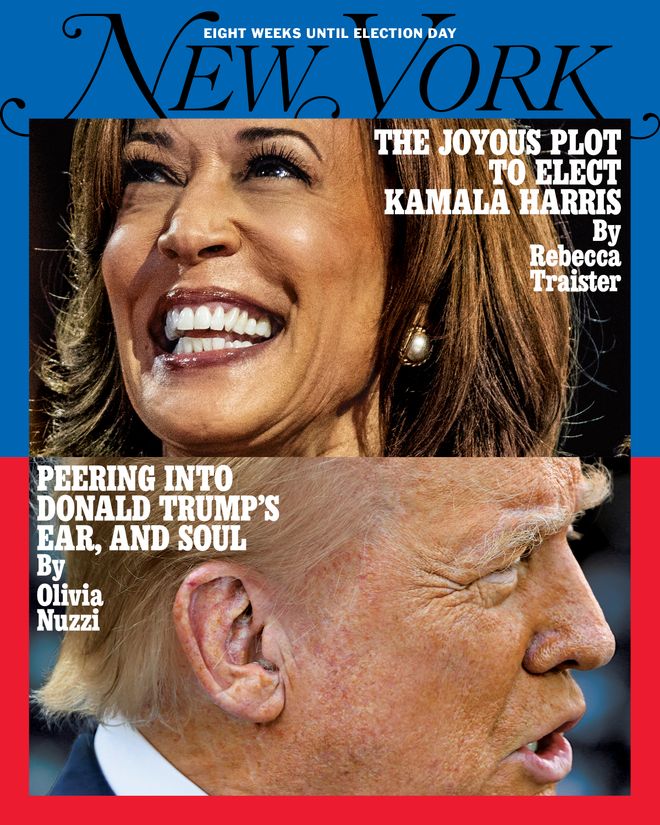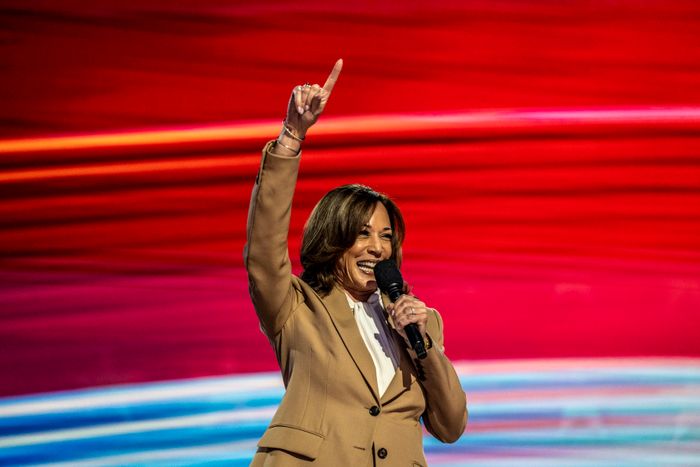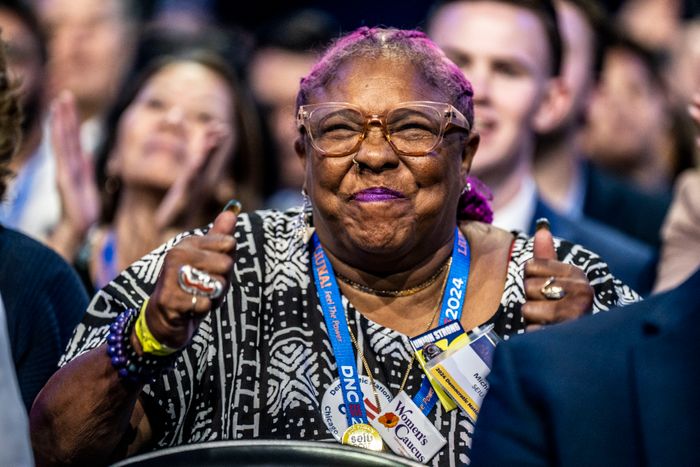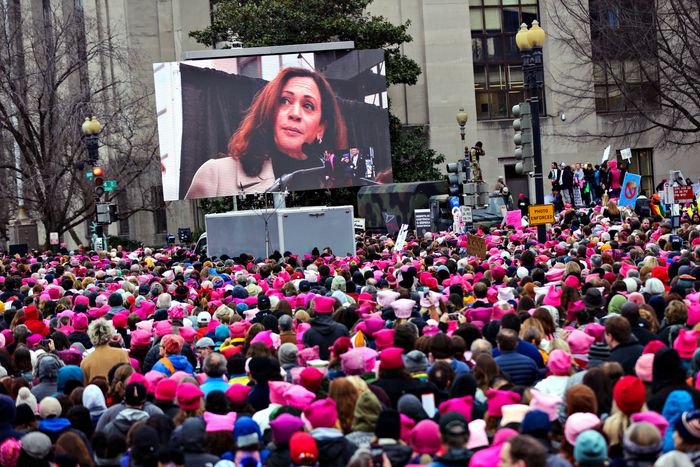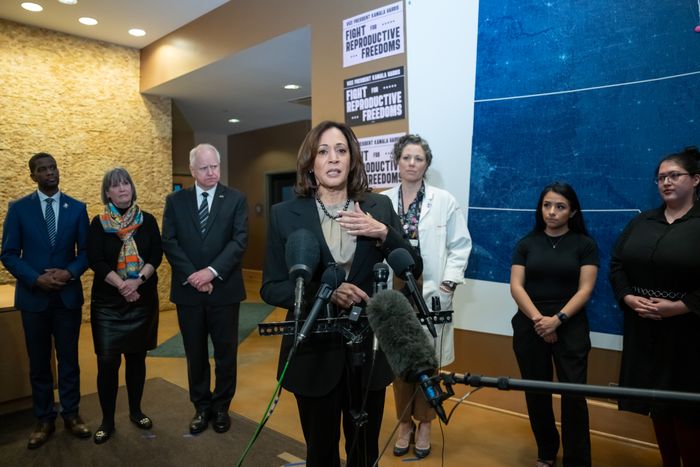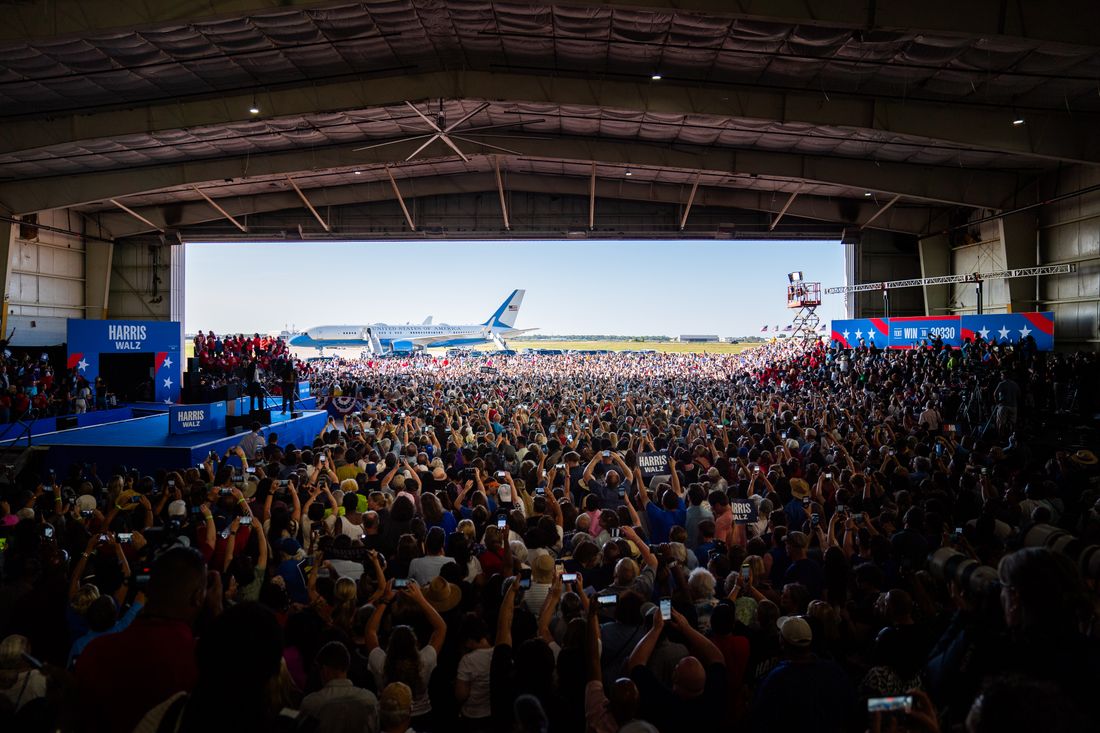
In August 2020, when Joe Biden was teasing the fact that he was choosing his running mate from a group of Black women, Jotaka Eaddy, formerly of the NAACP, was concerned with what she felt was the media and political Establishments’ racist and sexist treatment of the potential candidates, who included Stacey Abrams, Karen Bass, Susan Rice, Val Demings, Keisha Lance Bottoms, and Kamala Harris.
Eaddy placed a call to Minyon Moore, a Democratic National Committee official who, along with Donna Brazile, Leah Daughtry, and Yolanda Caraway, is part of a group of veteran Democratic strategists who call themselves “the Colored Girls.” Moore advised Eaddy to organize other Black women to defend and build support for these candidates.
Eaddy founded the Win With Black Women call, a weekly virtual gathering of Black women, held on Sunday nights, that typically draws anywhere between 150 and 1,000 participants; they have featured Oprah Winfrey, Dawn Staley, and practically every Black woman to run for office in the Democratic Party in the past four years. Yet the calls were founded, to some degree, on behalf of Harris’s historic inclusion on the presidential ticket.
In This Issue
So on Sunday, July 21, of this year, when Biden surprised his campaign and the political press by announcing he was stepping aside and endorsing Harris as his successor, Eaddy realized that night’s call might draw a lot of people. She was working to accommodate as many as 3,000, then found herself negotiating with Zoom executives to make room for the tens of thousands more clamoring to get in. Zoom ultimately made it possible for 44,000 participants to join, while 30,000 people who’d initially been denied entrance got on a Clubhouse link and another 10,000 got on someone’s conference-call line.
Win With Black Women’s goal was to raise $1 million in 100 days. Eaddy posted a fundraising link at 11:10 p.m., and by the time the call ended, at 1 a.m., it had raised $1.6 million, part of the jaw-dropping $81 million Harris hauled in that first day, much of it from first-time, small-dollar donors.
Before Sunday was over, Quentin James, Bakari Sellers, Khalil Thompson, and Michael Blake, who in recent months had been organizing Black men using Eaddy’s model, were planning for a Monday call, through which more than 53,000 participants would raise $1.3 million. Two nights later, in consultation with Eaddy, white women’s Answer the Call drew 164,000 people and $8.5 million. The next week, again with Eaddy’s guidance, 200,000 white men pulled down $4 million in a gathering that lasted north of three hours and featured both the Dude and Luke Skywalker. There would be Evangelicals for Harris and Dead Heads for Kamala; when I spoke to Eaddy in August, she told me about Realtors for Harris and Cooking for Kamala. “Last night, Swifties for Kamala had 34,000 people,” she said.
It was manic and strange and exhilarating. Mallory McMorrow, a state senator from Michigan, told me that one consultant had told her the calls were cringe, but McMorrow saw that cringe as part of what made the gatherings great and important. “They’re not from the campaign,” she said. “It’s random groups of people making them; it feels real.”
The realization, McMorrow noted, “that there’s other people who feel the same weird way about things that you do” is an unmanufacturable binding force, the glue of coalition building. A male friend texted her during the white-women call on which she spoke: “‘You’re telling me that 150,000 white women are voluntarily on a Zoom call, for four hours, two years after COVID? Trump is fucked.’”
The Beltway has simmered this summer with the spicy tale of Nancy Pelosi as party puppeteer, deploying the sheer force of her terrifying will to knock a stubborn sitting president off a ticket and steer her party into a new and exuberant future. But that story is only half-cooked.
Pelosi might indeed have exerted her formidable influence to edge Biden out. But it was not she who fueled Kamala Harris’s astonishing rise as the Democratic candidate. There were swift endorsements from Biden and party bigwigs including the Clintons and Alexandria Ocasio-Cortez, yes. And Harris immediately got to work whipping together a coalition, reportedly placing a hundred calls to legislators, governors, and labor and civil-rights leaders in the first hours of her would-be campaign. But no one in the party had any real sense of the degree of public support for a Harris presidency until that call with the Black women, whose initial gathering at that crucial moment, when the party could have gone in another direction or fractured into a million pieces, instead surprised everyone with its urgency and force and piles of money, and essentially foreclosed the possibility that anyone but Harris would take the crown.
It had been nearly 60 years since a Democratic president stepped down of his own volition, and the story of the party getting Biden to do so was nothing less than extraordinary. But just as extraordinary was what happened next: hundreds of thousands of ordinary people launching a blitz of electoral organizing, fund-raising, and rallying, the likes of which American politics hasn’t seen since at least 2008. In the bad old days of July, when the hunger was for anyone coherent to replace Biden, even many of those pushing for Harris likely expected her to campaign as a replacement-level Democrat — and were okay with that! No one imagined airplane hangars crammed to the rafters with chanting people or that anyone would associate the concept of “joy” with a party that seemed all but ready to hand back the presidency to Donald Trump. And this summer’s shocking turn of events was engineered not by any consultant or strategic mastermind but by committed Democrats on the ground who, perhaps realizing that few in leadership had any solid plan to save them, took matters into their own hands.
“For those at the top, this is a political moment,” said Abrams. “For the grass roots, this is a survival moment. The reason 40,000 Black women wanted to swarm onto a call was that they represent organizations that have been desperate for someone to say ‘We see you, we hear you, and we actually think we can do something about it.’”
“This is grassroots,” said Eaddy. “The people for Kamala Harris in the truest sense.” Al Sharpton told me at the Democratic National Convention in Chicago, “Harris came out of an organic movement. When she became the nominee, many people felt that she’s the nominee because we helped make her the nominee, including for vice-president. She’s our candidate.”
As we settle into the second phase of this candidacy and old hands regain control in preparation for the presidential debate on September 10, the question is whether the cautious, moderating forces that have long guided Democratic electoral politics will tamp down the people’s power that was unleashed this summer and jeopardize Harris’s chances of victory. And also whether those in charge in the Democratic Party and in the Washington press corps even understand where that power comes from: a true women-led movement, built over decades and given new life in the aftermath of Hillary Clinton’s defeat in 2016, working in service of a female presidential candidate running on a set of policies around housing, care work, abortion, health care, and labor that this candidate understands to be inherently, but not exclusively, “women’s issues.” It is a movement galvanized by a devastating setback for women’s rights — for civil rights — that seeks to rectify that wrong and usher in a new era of American politics.
“It feels like finally our political culture is catching up to the extent to which women are shaping politics and shaping our democracy,” said Ai-jen Poo, senior adviser for Care in Action, a domestic-workers organization. “Women are owning and organizing to protect democracy in a totally different way.”
Those who helped nudge Biden aside, by many accounts the heroes of this story, certainly weren’t doing it with a clear view of Harris taking his place. According to sources who asked not to be named, senior Democrats, including Pelosi and Barack Obama, were discussing plans for a mini-primary, which might have left anyone victorious.
Public talk of an open nominating process came from Pelosi, the New York Times’ Ezra Klein, Jim Clyburn, David Axelrod, and even George Clooney in his catalytic Times op-ed calling for Biden to step down. Pundits and donors were playing fantasy football, pitting the Democrats’ bench of imagined future standard-bearers against one another, stirring up rivalries among Gavin Newsom (a Pelosi favorite who spent July practically running a shadow campaign while camping out on cable-news sets where he vociferously defended Biden), Pete Buttigieg, Gretchen Whitmer, and yes, sure, sure, sure — of course! She should be in it too! — Harris herself.
Everyone had their arguments, though the politest way to articulate them was “We wouldn’t want it to look like a coronation.” Which was awfully strange since the ascension of a vice-president to the top of a ticket on which she has already been a candidate isn’t anything like a coronation, while deposing both an elected president and his second-in-command might look like a coup. Yet Washington’s political and media upper echelons during those agonizing July weeks were eager to point out that Harris didn’t poll well, that she wasn’t a good communicator, that she was perceived as too radical, that a woman, let alone a Black woman, was too risky.
Dmitri Mehlhorn, an adviser to Democratic megadonor Reid Hoffman, reportedly warned a call of leading Democratic operatives, “Kamala Harris is more threatening to those swing voters than a dead Joe Biden or a comatose Joe Biden.” On the day Biden stepped down, Axelrod told CNN that Harris’s supporters were doing her a “disservice” by arguing that she couldn’t be bypassed: “The real case they should be making is why she’d be the strongest candidate.”
Meanwhile, people who wanted Biden to hang on were fuming at the idea of leapfrogging the sitting vice-president, concerned that it would feed intraparty fighting, invite legal challenges, and alienate Democrats’ long-underrepresented Black female base.
Ocasio-Cortez’s die-hard support for Biden has been widely interpreted as a shortsighted blunder in which she tried to extract concessions for the left from a doomed presidential candidate — which it very well might have been. But days before Biden stepped back, Ocasio-Cortez conducted an hourlong Instagram Live in which she made clear that her ambivalence wasn’t just on behalf of him; it was rooted in her view, from inside the Democratic Establishment, of the plans to oust both him and his vice-president.
“I’m here to tell you that a huge amount of the donor class and these elites who are pushing for the president not to be the nominee also do not want to see the VP be the nominee,” she warned. “I have stood up in rooms with all these people, and I have said, ‘Game out your actual plan for me’ … I’m talking about the lawyers. I’m talking about the legislators … I have not seen the plan.”
The reasons Biden endorsed Harris right away remain murky. Was it a hunch that relief and joy would sweep his party as a result? Probably not, given his insistence in the weeks leading up to his withdrawal that he was the only Democrat who could keep NATO together or beat Trump. Was it pride in his vice-presidential pick, a desire to cement his legacy as the man who brought us our first female and first Black and first Indian American vice-president? Maybe. Was it the livid president’s desire to stick a shiv into people like Pelosi and Obama, whom Biden never forgave for passing him over when he was vice-president and who appeared to be pushing him out in order to install their preferred candidate? This would also check out.
In any event, Pelosi was not among those immediately endorsing Harris on the day Biden withdrew; neither were Chuck Schumer or Hakeem Jeffries. Obama did not endorse Harris right away either, instead expressing his “confidence that the leaders of our party will be able to create a process from which an outstanding nominee emerges.”
Whatever reservations these leaders might have had were swept aside by a fervor for a Harris presidency that few people in Washington could have predicted. In her first week, she raised $200 million, two-thirds from first-time donors; more than 170,000 people volunteered for the campaign. The first day alone, 28,000 people signed up, more than 100 times what the Biden campaign had been seeing on an ordinary day. Within 48 hours of Biden’s stepping aside, I was crossing the street carrying a newly minted HARRIS sign for my kids and was greeted by honking horns, thumbs-up, people yelling from cars, “Where did you get that?” As Eaddy put it to me, “If you’ve seen The Wiz on Broadway, it was like when they sing ‘A Brand New Day.’”
The Win With Black Women call “really set the tone for the energy and momentum we’ve seen,” said Harris’s campaign manager, Julie Chávez Rodríguez, who is the granddaughter of famed labor activist César Chávez and describes herself as “an organizer by birth and by blood.”
One person who worked for Clinton in 2016 and afterward for Biden called me that first week nearly in tears. “They were just there for her,” she said, marveling at that first Sunday call. “It’s like these women just knew what to do. They formed a protective cocoon or maybe a kind of platform that could raise her up with joy and confidence. It was just like, ‘We got this. We got you.’”
It is to the leadership’s credit that within days, everyone had gotten in line without public acrimony, and soon they were jockeying to be recognized as the architects of the Harris juggernaut. Clyburn has claimed that he pressured Biden to endorse immediately, while sources close to Obama, who endorsed Harris that Friday, assured the Times that his delay wasn’t due to his having any alternate candidate in mind but rather that he’d “wanted Sunday to be about” Biden and saw his role as coming in “to unite the party once we have a nominee.”
But a sense of unity was already in place. “In organizing,” Abrams told me, “one of the terms of art is ‘If you stay ready, you don’t have to get ready.’”
“You can see people reaching in and wanting to be a part of this and fuel it,” said Whitmer, a co-chair of Biden’s campaign and now of Harris’s. “Normal people. People that were sitting on the sidelines are now activated, people that were at the Women’s March and see that this is the moment where we can use organizing to push Kamala Harris over the finish line. The reason we’re having so much success as a campaign is because that work has been done — not finished, but the ground game has been growing — at that grassroots level over the last eight years.”
On night one in Chicago, there was some tittering about the choice to snuggle Ocasio-Cortez’s speech in so close to Hillary Clinton’s. According to the conventional wisdom, Clinton is a depressing reminder of loss, a candidate so bad that she could not beat the worst man on earth, and a representative of the stultifying political order. Ocasio-Cortez, through a similarly critical eye, is a disruptive problem child who represents an alienating strain of the far left.
These two women, in other words, are often portrayed by those who shape our political caricatures as villainous for opposite reasons: one center, one left; one Establishment, one fringe; one unpalatably old, one unbearably green. Yet when the young democratic socialist took the stage, the crowd of normcore delegates, who would wave their flags and USA signs lustily throughout the week, gave her a stomping, chanting, arena-shaking reception. Not an hour later, they were on their feet again, offering the same and more to Clinton, pounding the floor, their cheers of “HILL-A-RY!” echoing the “A-O-C!” ’s with which the hall had so recently reverberated.
“You can’t map ideological preferences on a single thing,” the progressive strategist Anat Shenker-Osorio reminded me during a conversation about swing voters. “We develop preferences and make decisions based on impressionistic narratives and stories.” For plenty of people, Ocasio-Cortez and Clinton are not at odds but rather part of the same impressionistic story in which Democratic women have struggled to gain power within their own party while the GOP takes away their rights.
Because of Clinton’s loss, because of Harris’s dismal primary showing in 2020, and because of Elizabeth Warren’s failure to secure the nomination that same year, many wise heads had concluded morosely that this country remains simply incapable of electing a woman president. They have also tended to dismiss the pussy-hat wearers and other mobilized women as both embarrassingly basic and politically ineffective, without recognizing how much impact this contingent has already had, or its determination to elect more women.
Throughout the convention, the most thunderous rounds of applause, besides those for Harris herself, went to Clinton and Ocasio-Cortez, to Michelle Obama and Warren, whose welcome was so extended that it brought the Massachusetts senator to tears. These are all women who many have fantasized (however baselessly, in the case of Obama) might someday lead the nation. They are ideologically different, stylistically different, come from different generations and communities, yet are yoked to one another as part of an imaginative project that remains close to the heart of millions: doubling the size of the pool from which we fish for our presidents.
A lot of people want to elect a Democratic woman president of the United States. And a lot of them took our most grievous failure to do so, in 2016, not as a confirmation of futility but as a challenge to figure out how to do better next time.
“The realization that we can actually make this possible,” said longtime labor organizer Dolores Huerta, “that all of us coming together can elect the first woman president of the United States, is such an exciting goal.”
Harris is benefiting from the intense ground-level electoral engagement provoked by Clinton’s loss. It’s worth noting how much of the 2016 result, in which Clinton did win a majority of American voters, stemmed from the certainty on the part of those running her campaign, the Democratic Party, and the political media that she would take the White House and that Trump could never. Millions of Americans didn’t act in advance of November 8, 2016, in part because no one had made clear to them that they had to, that this was an emergency — and they then awoke on Wednesday morning to an emergency. At which point legions of them began to change their relationship to politics and civic participation.
The Women’s March took place the day after Trump’s inauguration, and the sea of ordinary people was so much larger than Trump’s party that it became the original trigger for the former president’s obsession with crowd size.
Kamala Harris, having been sworn in for her first Senate term not three weeks earlier, spoke at that march. “Even if you’re not sitting in the White House,” she said, “even if you’re not a member of the United States Congress, even if you don’t run a big corporate super-PAC … you have the power. We the people have the power. And there is nothing more powerful than a group of determined sisters, marching alongside with their partners and their determined sons and brothers and fathers, standing up for what we know is right.”
People, and especially women, began to flex their organizing muscles. New groups sprang up, including Run for Something, which boosted a new generation of Democratic candidates into office, and Sister District, which matched blue-state volunteers with state-level races in swing districts. There was the Movement Voter Project and Indivisible. They joined organizations that had long been on the ground, including Higher Heights and Emerge, with programs to recruit and train female candidates, young candidates, progressive candidates, and candidates of color to run for office in places and at levels the party had ignored for decades.
McMorrow, a former industrial designer who literally Googled “how to run for office” after Trump’s victory, ran her first race in 2018 with the help of Emerge and Sister District, which flew in volunteers from California to knock on doors for weeks before the election. (Since 2016, Sister District has endorsed 177 progressive candidates in 18 states; 115 of them have won their races.) McMorrow flipped her red district blue. In 2022, her reelection was part of the blue wave in Michigan that gave Democrats control of the legislature for the first time in 40 years.
“Pelosi always says the Class of 2018, a lot of us in leadership now, saved America,” said Representative Lucy McBath, who became an anti-gun-violence organizer in the wake of her son’s 2012 murder and flipped her Georgia House district in 2018. “I think it’s because a lot of us didn’t have any intentions of ever being in office. We bring our lived experiences, our different realities.” Without the organizing in the wake of 2016, McBath said, nodding toward Harris, who was onstage making her surprise appearance on the first night of the convention, “I don’t think we’d be where we are today.”
“Women-led grassroots organizing gets dismissed by the Beltway class,” texted Katie Paris, who founded Red Wine & Blue in advance of the 2020 election. The group organizes multiracial suburban women, a Democratic response to the Moms for Liberty groups driving Republican turnout; Red Wine & Blue now has 500 groups nationwide, compared with Moms for Liberty’s 310. “But they really may have no idea what’s been going on in the middle of America,” Paris said. “Do they have any idea that we organize in our communities year-round and not just around elections? That we pay attention not just to presidential races but to school boards and school levies and whatever else needs tending in our communities? I was just listening to NYT Nate on The Daily and it’s like they have no comprehension of any dynamic outside of the candidates and their campaigns. It’s like they’re trying to report on the storm without checking the weather.”
It’s true that too few in the upper reaches of American politics take this level of organizing seriously, even as these efforts have, more than once in the past eight years, saved the Democratic Party in elections that everyone predicted it would lose, corrected its long-term failures to build state and local power, and ushered a new generation into office — composing a Democratic winning streak that stretches back not just to Dobbs but to Democrats flipping 15 seats in the Virginia House of Delegates in 2017.
Frankly, had there been a do-over one week later, it seems likely Hillary Clinton would have won the 2016 election in a landslide.
Not just any 2024 presidential candidate would have proved a well-matched vessel for these energies. But Harris, while never associated with activist politics, has been more cognizant than many of her peers about what has been happening on the ground, not just recently but throughout her career. Listen to her speak and you’ll hear phrases lifted directly from activism, from “Trust women” to “When we fight, we win,” which, according to the Washington Post, originated within a Boston anti-eviction movement with roots in civil-rights organizing.
“The power of the collective is so important,” Harris said to a call of 3,000 people organized by Win With Black Women, Red Wine & Blue, and Sisters Lead Sisters Vote four days before the November 2023 elections. “Let’s remember that the strength of our nation has always relied — whether people don’t want to tell true history or not — on folks like the women on this call, who believe in what is possible and fight for us to get there.”
Harris was raised by her activist mother, who made sure she was steeped in a culture of “marching and shouting for civil rights” in 1960s Berkeley, and by a caregiver, Mrs. Shelton, whom she often speaks about as key to understanding the centrality of care work to American lives and communities, which many expect to be a keystone of Harris’s economic agenda. Ai-jen Poo reminded me that Harris, when she was San Francisco district attorney, was also the caregiver to her mother, then sick with cancer. “When she is in a room with care workers,” Poo told me, “that connection is like fire. People feel seen and understood. And when you feel invisible, that feeling of recognition and reflection is very electric.”
Recognition and reflection, seeing and hearing the people with whom you are aligned, are essential to bottom-up coalition building. Harris was a prosecutor, definitionally a representative of the system. She chose that path when it was among the only ways for a politically ambitious Black woman to gain power within that system. Yet there are very few who have climbed as far as she has within politics who also worked at McDonald’s, a job she described in 2019 when she addressed SEIU workers picketing for a $15 minimum wage; few presidential nominees have tended to a sick mother while working as a district attorney. As senator, Harris endorsed a domestic workers’ bill of rights. None of this makes her any less a cop. But it better enables her to recognize the labor done by millions outside the prosecutor-to-president pipeline.
It is Harris who has been crisscrossing the country over the two years since Dobbs, the administration’s most powerful voice in the fight to restore abortion rights and access. Abortion is the issue that has enabled her to distance herself from memories of her disappointing 2020 presidential run, in which she was too often wooden, defensive, and unsure of herself. It has also allowed her to emerge from the shadow that had fallen over her during the first half of the Biden administration, during which she had been given the worst jobs, including the border, and was regarded as something of a disappointment.
“Nobody thought she could win, nobody liked her, she was sucky as vice-president,” former senator Claire McCaskill said in a babyish voice, mimicking the underestimations of Harris she has heard in the media and her party for years. The job of vice-president, McCaskill observed, is an inherently “diminishing role. So getting your sea legs takes a bit. She was taking the criticism to heart too much, and I think she got a little wobbly her first couple of years.” But, McCaskill continued, “I think she realized, as Barbara Mikulski used to say, ‘Button the jacket of your pantsuit, put on your lipstick, square your shoulders, and go fight.’ Particularly when Dobbs happened, because Joe Biden was never comfortable saying the word abortion, much less campaigning on it. But she was very comfortable, and you sense that.”
On the May 2022 night that the Dobbs decision leaked, Harris was speaking at an EMILY’s List gala. “The words she said onstage were ‘How dare they?’” said California senator Laphonza Butler, who was then president of the organization. “The words she said backstage were much more colorful.” Butler remembered that night as the moment when Harris “realized the far reaches the extreme right would go, and she just said, ‘You know what? Fuck being perfect for everybody else. I’m going to be me because the me that I am is a fighter.’”
Harris’s approach to the fight was rooted in the women-of-color-led reproductive-justice movement, linking abortion rights to other inequities, including the country’s high maternal-mortality rates and lack of affordable housing, paid leave, and child-care provisions. She moved away from zero-calorie Democratic tropes about “choice” and “safe, legal, and rare” and instead recast abortion as a fundamental freedom — the buzzword of her current campaign, which she and others on the abortion front lines have been using for years.
In 2023, Harris told me she came to the abortion battle “as someone raised by parents who were active in the civil-rights movement and a mother who fought for women’s-health issues.” Abortion rights, she said, are predicated on “our collective ability to exercise self-determination,” noting that people’s “freedom to make certain decisions about their own life, and who they love, and their own bodies — those are the attributes of a democracy.” For women under 45, according to the Times, abortion has become the most important issue of the election, surpassing the economy.
Harris has also sought out those who have been (in movementspeak) doing the work. She was the first sitting vice-president to invite abortion providers to the White House and the first to visit an abortion clinic; it was at a clinic in St. Paul, Minnesota, that she first meaningfully encountered Tim Walz, now her running mate.
When she speaks of “sisters,” as she often does, Harris is making reference to both multiracial political alliances and a kind of sisterhood in which she was personally steeped. Harris was an AKA at Howard University and knew the power of her collegiate sorority network. She was the first vice-president to invite the heads of the Divine Nine — the nine most powerful Black fraternities and sororities, with more than 2.5 million members nationwide — to the White House; in July, she delivered a speech at AKA’s annual convention, and her first public event after becoming the surprise nominee was with Zeta Phi Beta. AKA, which has long coordinated voter-registration and mobilization drives, launched a PAC in August to support Harris’s candidacy, while another of the Divine Nine, Delta Sigma Theta, aired its first-ever get-out-the-vote ad in Philadelphia and Chicago.
It’s hard to stress how unprecedented it is for a presidential campaign’s official launch to be powered by Black-sorority and abortion-related groups. There was no elaborate advance planning for this, but that’s sort of the point: Where was Harris when the music stopped and she became the nominee? Already talking to Black women and abortion providers and storytellers.
In the first days of Harris’s takeover of the ticket, the Democratic Party, so frequently reported to be “in disarray,” appeared in breathtaking amounts of array: functional! Unified! Jubilant!
But it is not even Beltway backbiting to point out that the actual Harris campaign was a mess. How could it have been otherwise? Biden loyalists, 80 percent of the way through a presidential race, were suddenly mashed together with Harris’s own team, with whom there had never been a particularly warm relationship, all with 107 days to put on a show that is usually 18 months in the making. Soon, Obama world had layered on senior advisers David Plouffe and Stephanie Cutter, creating, as one presidential-campaign veteran said to me, “a campaign Mr. Potato Head” — a team with six eyes, three legs, and maybe no arms. (Chávez -Rodríguez denied there was disorganization, confusion, or tension in the campaign transition.)
It’s a tribute to the strength of both the candidate and the Democratic base that pulled out every stop to rally behind her that any top-level dysfunction did not dampen spirits. Nowhere was that more evident than at the convention, where logistics were terrible, lines were hours long, COVID was rampant, chicken fingers were expensive, big moments were pushed well beyond prime time, and most people were having a ball, practically levitating. “People felt like it was their convention, and that felt so new,” Poo told me. “Just the range of voices, from the climate guy from Appalachia to all the kids onstage — and Gus Walz! The people were fighting for the story; they felt like they could actually own it, and I didn’t know I would see that in my lifetime.”
McMorrow told me about how, after the big Harris-Walz rally in Detroit in August, a parking-lot jam left attendees stranded for hours. She wound up walking four miles with a group from United Food & Commercial Workers. “We decided, ‘It’s nice out, let’s walk. We feel good.’ Nobody was angry about it. Everybody was just happy to be there.”
What Harris and her sprawling, stitched-together team were expert at was capably crowd-surfing the happy-to-be-there energy that rose to meet her, reflecting the release from purgatory right back at the cameras and crowds, flashing her enormous smile and letting loose her wacky laugh. “One of the superpowers that she has,” said Butler, “is all those videos out there of her dancing with young people, cussing, marching with workers on picket lines or talking about her experience at McDonald’s — it’s like the grass roots can see themselves in her.”
“Great organizers,” said Poo, “embody that Maya Angelou quote, which is that people don’t remember what you say; they remember how you made them feel.” Harris was making people feel good and hopeful about the future, and she seemed to understand in her gut how important that was to actually winning an election. Early on, CNN reported that veteran Democratic pollster Geoff Garin had advised the campaign to stop saying “We’re not going back” and using the term weird. Harris declined to follow Garin’s advice, CNN noted, asserting that she “wasn’t going to listen to the pollsters herself and would instead trust the instincts she had buried under self-doubt for so long.”
Those instincts told her to act like someone who was not just suddenly at the top of her party but part of a rowdy, happy coalition. She took the elation she was receiving from the crowds and made that energy the motif she would return to again and again: joy.
While surely every number cruncher in Greater D.C. was advising her to pick Pennsylvania governor Josh Shapiro for vice-president, Harris went with Tim Walz, a favorite of the internet masses, who saw him as lovable, progressive, and a crucial couple of ticks to Shapiro’s left on Israel. “When she picked Walz,” veteran campaign strategist Rebecca Katz told me, “it was like hope came back. She trusted her gut, not a poll. And no one has done that in Democratic politics in a long time.”
The campaign also showed itself to be in conversation with young people, who were making memes and using words D.C. campaign veterans could barely understand, much less deploy smoothly. But Kamala HQ’s social media dressed itself in Brat green; a team of young staffers issued press releases written in internet patois, responding to one of her opponent’s deranged press conferences with a “Statement on Trump’s … Whatever That Was.” And Lil Jon appeared at roll call to make a “to the window, to the Walz” reference that no one over 45 was likely to get.
It might have felt as though the campaign had devised some exquisite social-media operation, but it was mostly doing a thing that is important in movement building: reflecting back what was being projected at it. As the pollster Tresa Undem, who specializes in attitudes around gender, told me in August, “The social-media reaction from Gen Z and millennials is absolutely off the charts, and I’ve never seen anything like it. But for her campaign to reflect it? I’m blown away every day.”
The approval she got this summer gave her swagger, and she spoke with a vivid assuredness not often heard from a party that has too frequently been mealymouthed in its commitment to humane and moral policy positions. Shortly after rolling out economic proposals, including an expanded Child Tax Credit and EITC and money for first-time homebuyers, Harris was asked how she plans to pay for them and she didn’t flinch. “When you are strengthening neighborhoods, strengthening communities, and … investing in a broad-based economy, everybody benefits and it pays for itself.”
This kind of unapologetic muscularity felt like a balm, which made it all the more worrisome that, in perhaps the biggest fumble of her young candidacy, Harris did not listen to those who were asking her to find a way to bridge the vast chasm between the Biden administration and what so many young people energized by her campaign also want: an end to Israel’s assault on Gaza.
Despite the lobbying efforts not only of activists but of party members including Ilhan Omar, Ayanna Pressley, and Ocasio-Cortez, there was no speech from anyone of Palestinian ancestry on the convention stage. It would have been a simple gesture, especially alongside the parents of Hersh Goldberg-Polin, who was subsequently executed by Hamas, that would have acknowledged the humanity of those tens of thousands of Palestinians also killed in Israel’s siege. Politically, it would have sent a crucial message to those who want to support her campaign but find the administration’s steady provision of deadly weapons to a Netanyahu government morally intolerable.
At the convention, where organizers gathered for a sit-in, Ruwa Romman, the first Muslim woman elected to the Georgia House of Representatives and one of the people who could have addressed the convention, told me, “If we didn’t care about the party, if we didn’t care about defeating Donald Trump, we would not be doing all this. I would much rather be at home cuddling my dogs and my husband.” She sounded like any number of women I have spoken to over the past eight years who have turned their lives upside down to become engaged in electoral politics, the women from whom Harris is drawing so much energy. “The excitement about Harris is real and genuine because this moment is historic,” Romman said. “What we are trying to do is we are trying to literally protect the vibes.”
The euphoria coming off the Harris campaign’s summer set it up for an autumn comedown. Not just the “poller coaster” or post-honeymoon dip that would have followed any post-Biden bounce but something more deflating, perhaps because the energies of August so dramatically exceeded expectations.
By late August, those at the top had regained control of the wheel, and you could feel it. Harris began to sound like a politician. Even toward the end of the convention, the drive to retake the language of patriotism for the left had become uncomfortably jingoistic, and in her speech, Harris celebrated the U.S. military as “the most lethal fighting force” in the world. The following week, in a CNN interview, she appeared overcareful, unwilling to come out boldly for her own ideas, instead directing her attention toward voters whom party leaders have long imagined to be sitting in some vast ideological middle-right; she promised to appoint a Republican to her Cabinet, and the campaign touted endorsements from Cheneys and a McCain. A batch of polls in the first days of September showed the race tightening and some of Harris’s big initial gains in states like Arizona and Michigan beginning to erode. As the country briefly took a breath in anticipation of the September 10 debate with Trump, it did feel a bit like something had stalled.
A presidential campaign is not a social movement. A presidential campaign has to win the Electoral College. And eleventy-hundred high-level Democratic consultants could jump in here to assure you that you win the Electoral College by talking about the lethality of America’s military. But that wasn’t how the campaign outperformed every high-level consultant’s estimation of its potential a month ago. “In any movement, you have to have a balance of what is top-down and what is bottom-up,” said Shannon Watts, the founder of the anti-gun-violence group Moms Demand Action and the organizer of the white women’s call. “Because if you don’t have enough of one or the other, you either become too controlling or it becomes chaos.”
Harris’s campaign, at its most movementlike, was never shaped around explicitly leftist principles or ideology, though it radiated a mild progressivism. Instead, the organizing that fed its surge is most simply described as a move toward something amorphously different from what has come before, generationally, representationally, and politically — a break with the milquetoast Democratic politics that have hindered fights for equality and inclusion and have played their own part in keeping a woman from the White House.
It is easy to forget how endless and thankless the work on the ground has been, how long it has been going on. As the feminist lawyer Florynce Kennedy once observed about the byword for this year’s Democratic Party, “Freedom is like taking a bath; you’ve got to keep doing it every day.”
Or, as Hillary Clinton put it in her convention speech, remembering how she took her daughter to see Geraldine Ferraro run for vice-president in 1984 — which made me remember how my father took me to vote for Ferraro in 1984, and how I took my daughters to vote for Clinton for president in 2016, and how I will take them again to vote for Harris in 2024 — “I wish my mother and Kamala’s mother could see us. They would say ‘Keep going,’ surely. And Gerry would say ‘Keep going.’ Women fighting for reproductive health care are saying ‘Keep going.’ Families building better lives, parents stretching to afford child care, young people struggling to pay their rent — they’re all asking us to keep going.”
It was an echo of a speech Clinton had given at another convention, in 2008, in which she cited Harriet Tubman, reputed to have advised those she was leading out of enslavement, “If you hear the dogs, keep going … Don’t ever stop … If you want a taste of freedom, keep going.” It was the year of Clinton’s first presidential effort, which ended in defeat to Obama after a lengthy primary process and which reveals an example of what keeping going, through repeated loss and revision, can entail. Back in 2008, Clinton had been advised by her then–campaign manager, Mark Penn, that Americans “do not want someone who would be the First Mama” and that she should downplay her gender. It didn’t work. When she ran again in 2016, using “I’m With Her” and “glass ceiling” rhetoric to put the historic nature of her candidacy front and center, it was partly an effort to correct a previous misstep. It also didn’t work.
Eight years later, people who have learned from Clinton’s defeats are stepping in to take some of the tricky representational load off Harris. “The groups being able to talk about race, gender, identity, and power at the organizing level,” Watts observed, “freed them up from having to talk about it at the campaign level,” thus permitting Harris to wear her identity more lightly than Clinton could. Now, the notion of a woman president has become less fantastical. Harris can present herself simply as the best candidate, the fact that she would be the first woman president hovering only as a thrilling promise, neither a dirty secret nor the whole point.
These are the steady and ceaseless contributions to the group project that is America, made over decades, over centuries. They are a reminder that there is no final destination, including this November, but that progress requires a persistent willingness to try again; that no loss, nor any victory, is the end of the efforts of the people at the margins to make America great someday.
The people have the power, Harris told the Women’s March. The strength of the nation has always relied on the organizers, she told the Win With Black Women call in 2023. When we fight, she tells us now, we win. Maybe this time, we finally will.



